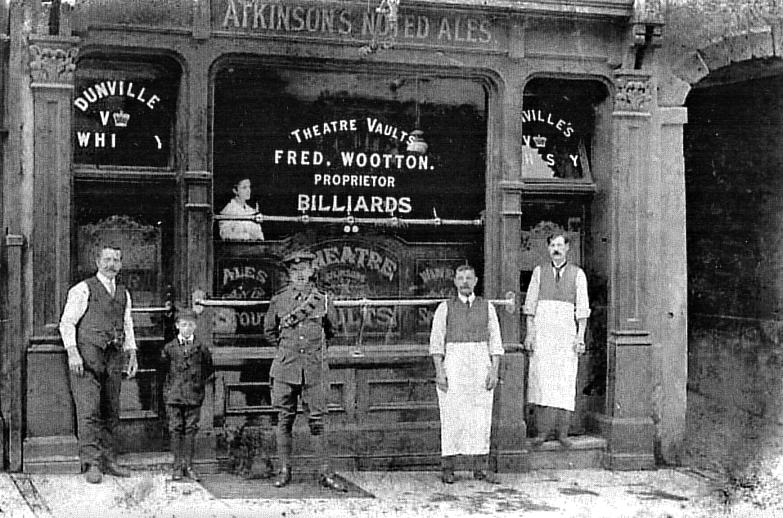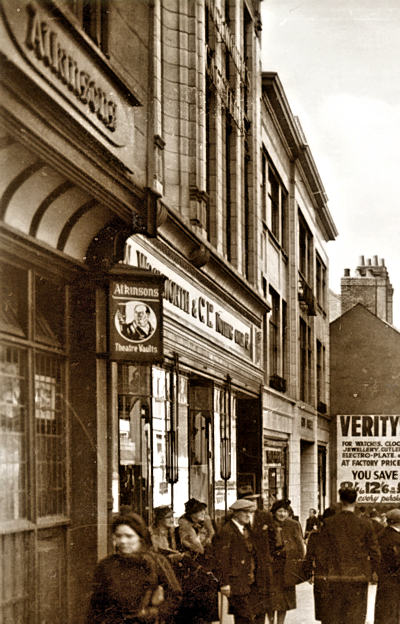Theatre Vaults, 17 Smithford Street
| Alternative Addresses: | 16 Smithford Street (from 1922) | ||
| These premises have been known by different names during their history: | FROM | TO | NAME |
| c1812 | 1883 | Liquor Vaults | |
| 1883 | 1940 | Theatre Vaults | |
 With thanks to Jo Roberts on Facebook for permission to use this wonderful family photograph, taken c1915. Fred Wootton had become the pub's licensee in December 1914, and his wife, Florence (Jo's great-grandmother's sister), can be seen looking through the window.  This pub opened as a wine and spirit merchants at the bottom of Theatre Yard, 17 Smithford Street.
in 1883 William Growcott Wright renamed it THEATRE VAULTS.
In 1889 the THEATRE ROYAL became the EMPIRE THEATRE OF VARIETIES (occasionally referred to in the press as the EMPIRE PALACE OF VARIETIES). The theatre was accessible through the THEATRE VAULTS entrance in Smithford Street.
Although this was a period of music hall boom, audiences gradually dwindled to the point where the theatre became uneconomic to run. Competition from two pub music halls did not help. Ellen Terry played there in November 1880. Even stars like Charles Coborn and Arthur Lloyd in 1895 could not reverse the financial state and the Empire closed permanently at Christmas 1895 and was demolished in 1903 - but not the THEATRE VAULTS which remained trading until destroyed by enemy action in 1940.
Our text includes concise descriptions taken from the book 'Coventry's Forgotten Theatre, The Theatre Royal and Empire' by Ted Bottle and published by Badger Press.
The Theatre Royal, later known as the Empire Palace of Varieties, was set back some way from the Street, and was not part of the pub building. The main entrance to the theatre from Smithford Street was through an alleyway which ran between the pub and the adjacent building, which at one time was Sir Skears Rew's house. This arched entrance can be seen on the right in the photograph above. One of the most famous people to tread the boards there was a black actor named Ira Aldridge, about whom a super article can be read on Historic Coventry.
The first permanent theatre building was erected in 1819 by Sir Skears Rew, a local businessman. Like other theatres of the period, the Royal ran a stock company for about two months in the year and was part of a local circuit. It suffered the general downturn in attendances during the 1840s and 1850s but managed to stay afloat whereas many others closed permanently. The interior was modernised in 1857 along the lines of newer theatres but initial public enthusiasm soon faded and it became a music hall in 1865.
Drama returned in 1868 with various stock companies but these gradually gave way to national touring companies who would stay for a week at a time and move on elsewhere. William Bennett, who took over in 1880, did much to improve the building but it was too small and inconvenient to provide for the elaborate productions then on the road. Bennett built the nearby Opera House for these shows and turned the Royal into the Empire Theatre of Varieties in 1889.
In February 1922 the Theatre Vaults had to be rebuilt in a location just next door to where it had stood for decades, in order to make way for the new F. W. Woolworth store. The new retail store was planned to be built next door to the old Theatre Vaults, but it was realised that it required the equivalent of three shop frontages in space, forcing a rebuild and change of address for the theatre from No. 17 to No. 16.
This pub opened as a wine and spirit merchants at the bottom of Theatre Yard, 17 Smithford Street.
in 1883 William Growcott Wright renamed it THEATRE VAULTS.
In 1889 the THEATRE ROYAL became the EMPIRE THEATRE OF VARIETIES (occasionally referred to in the press as the EMPIRE PALACE OF VARIETIES). The theatre was accessible through the THEATRE VAULTS entrance in Smithford Street.
Although this was a period of music hall boom, audiences gradually dwindled to the point where the theatre became uneconomic to run. Competition from two pub music halls did not help. Ellen Terry played there in November 1880. Even stars like Charles Coborn and Arthur Lloyd in 1895 could not reverse the financial state and the Empire closed permanently at Christmas 1895 and was demolished in 1903 - but not the THEATRE VAULTS which remained trading until destroyed by enemy action in 1940.
Our text includes concise descriptions taken from the book 'Coventry's Forgotten Theatre, The Theatre Royal and Empire' by Ted Bottle and published by Badger Press.
The Theatre Royal, later known as the Empire Palace of Varieties, was set back some way from the Street, and was not part of the pub building. The main entrance to the theatre from Smithford Street was through an alleyway which ran between the pub and the adjacent building, which at one time was Sir Skears Rew's house. This arched entrance can be seen on the right in the photograph above. One of the most famous people to tread the boards there was a black actor named Ira Aldridge, about whom a super article can be read on Historic Coventry.
The first permanent theatre building was erected in 1819 by Sir Skears Rew, a local businessman. Like other theatres of the period, the Royal ran a stock company for about two months in the year and was part of a local circuit. It suffered the general downturn in attendances during the 1840s and 1850s but managed to stay afloat whereas many others closed permanently. The interior was modernised in 1857 along the lines of newer theatres but initial public enthusiasm soon faded and it became a music hall in 1865.
Drama returned in 1868 with various stock companies but these gradually gave way to national touring companies who would stay for a week at a time and move on elsewhere. William Bennett, who took over in 1880, did much to improve the building but it was too small and inconvenient to provide for the elaborate productions then on the road. Bennett built the nearby Opera House for these shows and turned the Royal into the Empire Theatre of Varieties in 1889.
In February 1922 the Theatre Vaults had to be rebuilt in a location just next door to where it had stood for decades, in order to make way for the new F. W. Woolworth store. The new retail store was planned to be built next door to the old Theatre Vaults, but it was realised that it required the equivalent of three shop frontages in space, forcing a rebuild and change of address for the theatre from No. 17 to No. 16. | |||
LICENSEES:1882 - 1883 William Growcott Wright 1883 Arthur Henry Masser 1884 George Johnson 1884 - 1886 Thomas Horley 1886 James Whitaker (Jan to Mar) 1886 - 1899 Henry William Thomas 1899 - 1901 John Henry Gee 1901 - 1905 George Lawford (gained a music license at the same time) 1909 Theresa S. Phipps 1909 - 1912 William Frederick Hodgkins 1912 - 1913 Charles H. Scattergood 1913 - 1914 Robert Chester (died 26th August 1914 aged 38 - licence transferred to wife, Edith, 19th October) 1914 Edith Mary Chester 1914 - 1920 Fred Wootton 1920 - 1925 Joseph Rivitt 1925 - 1940 Samuel Marston | |||
 Street plan of 1851 | |||
| Previous page: Terrace Bar & Grill | This page: Theatre Vaults | Next page: Thistle |